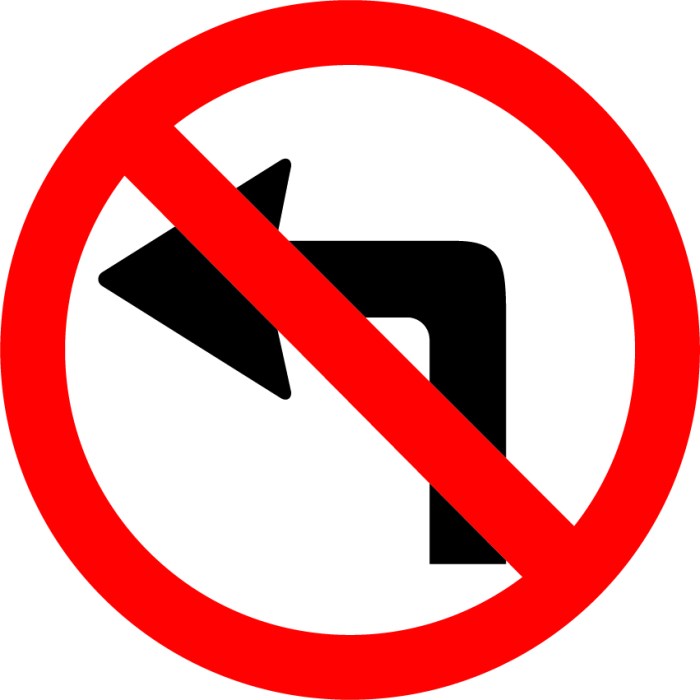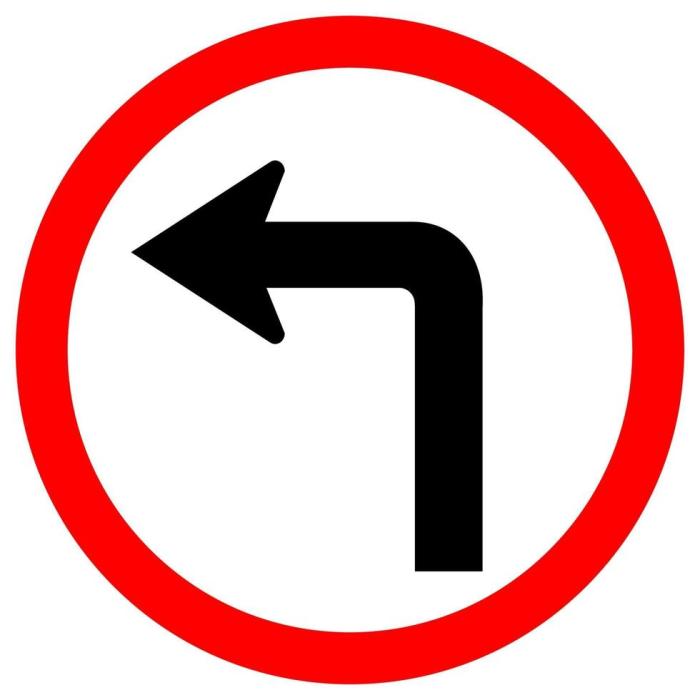Señal de girar a la izquierda – Left turn signals, an indispensable element of road safety, play a crucial role in ensuring smooth traffic flow and preventing accidents. In this comprehensive guide, we delve into the significance, legal requirements, design considerations, and cultural influences surrounding left turn signals, empowering you to become a responsible and safe driver.
Beyond their practical purpose, left turn signals hold cultural and regional variations that reflect diverse driving habits and societal norms. Understanding these differences fosters a broader perspective on road safety and promotes harmonious interactions among drivers.
Definition and Overview

A left turn signal is a device used to indicate to other drivers that a vehicle intends to turn left. Left turn signals are typically activated by a lever or button on the steering column, and they cause the vehicle’s left-hand turn signal lights to flash.
There are different types of left turn signals, including:
- Manual left turn signals:These signals are activated by the driver manually, and they stay on until the driver turns them off.
- Automatic left turn signals:These signals are activated automatically when the vehicle’s steering wheel is turned to the left. They turn off automatically when the vehicle has completed the turn.
It is important to use left turn signals when turning left, as they help to prevent accidents. Left turn signals let other drivers know that you intend to turn, so they can adjust their driving accordingly.
Legal Requirements and Regulations

Left turn signals are required by law in most jurisdictions to indicate the driver’s intent to turn left. Failing to use a left turn signal can result in a traffic citation or even an accident.
Consequences of Failing to Use a Left Turn Signal
The consequences of failing to use a left turn signal can vary depending on the jurisdiction. In some areas, it is considered a minor traffic violation, while in others, it can be a more serious offense. In some cases, failing to use a left turn signal can even lead to an accident.
Comparison of Regulations for Left Turn Signals in Different Jurisdictions
The regulations for left turn signals vary from one jurisdiction to another. In some jurisdictions, drivers are required to use their left turn signal at all times when turning left, regardless of whether there is any traffic present. In other jurisdictions, drivers are only required to use their left turn signal when there is oncoming traffic or pedestrians present.
The left turn signal, a ubiquitous sight on our roads, guides us through intersections with ease. It’s like a mathematical equation that Misha, a brilliant young mind, stumbled upon in his groundbreaking discovery . Just as the left turn signal illuminates the path ahead, Misha’s equation shed light on a hidden mathematical truth.
And as we navigate the complexities of life, these guiding signals, both literal and metaphorical, help us stay on course.
Safety Considerations
Utilizing left turn signals plays a pivotal role in enhancing road safety by providing clear communication of intentions to other road users. This helps prevent collisions, promotes orderly traffic flow, and reduces the risk of accidents involving vehicles, pedestrians, and cyclists.
Impact on Accident Rates
Numerous studies have demonstrated the positive impact of left turn signals on accident rates. According to the National Highway Traffic Safety Administration (NHTSA), using left turn signals can reduce rear-end collisions by up to 50% and side-impact collisions by up to 30%. These statistics underscore the significance of left turn signals in improving overall road safety.
Preventing Collisions
- Other Vehicles:Left turn signals alert oncoming vehicles to the driver’s intention to turn, giving them ample time to adjust their speed and position to avoid a collision.
- Pedestrians:By signaling a left turn, drivers provide pedestrians with a clear indication of their movement, allowing them to cross safely or take evasive action.
- Cyclists:Cyclists are particularly vulnerable to collisions with turning vehicles. Left turn signals provide them with advanced warning, enabling them to anticipate the driver’s intention and take appropriate measures.
Design and Visibility

The design of left turn signals plays a crucial role in ensuring their effectiveness. Key considerations include visibility, placement, and intensity.
Visibility is paramount for left turn signals to be noticeable and convey their intended message. Factors affecting visibility include color, placement, and intensity.
Color
- Amber (yellow) is the internationally recognized color for left turn signals, as it provides high visibility and contrast against various backgrounds.
- Red is sometimes used as an alternative color, but it can be confused with brake lights.
Placement, Señal de girar a la izquierda
- Signals should be placed on the front and rear of the vehicle, where they are easily visible to other drivers and pedestrians.
- Front signals should be located near the headlights to increase their conspicuity.
- Rear signals should be placed high enough to be visible over the trunk or cargo area.
Intensity
- Signals should be bright enough to be seen in all lighting conditions, including direct sunlight.
- LED (light-emitting diode) technology is often used in modern signals due to its high intensity and energy efficiency.
Innovative Designs
In recent years, innovative left turn signal designs have emerged to enhance visibility and safety.
- Sequential signals: These signals illuminate in a sequential pattern, creating a dynamic and attention-grabbing effect.
- Matrix LED signals: These signals use multiple LED elements to project custom patterns and symbols, providing more detailed and informative communication.
- Projection signals: These signals project a beam of light onto the road surface, creating a visible indication of the intended turn.
Maintenance and Troubleshooting

Maintaining left turn signals in optimal condition is essential for safe and effective communication on the road. Neglecting their upkeep can lead to confusion, accidents, and legal consequences.
To ensure proper functioning, regular inspections and maintenance are crucial. Visual checks should be conducted frequently to detect any damage or loose connections. Bulbs should be replaced promptly when they burn out, and wiring should be inspected for corrosion or fraying.
Troubleshooting Common Problems
If your left turn signal malfunctions, there are several common issues to consider:
- Burnt-out bulb:This is the most common cause of turn signal failure. Simply replace the bulb with a new one of the same type and wattage.
- Loose connections:Check all electrical connections, including the bulb socket, wiring harness, and fuse box. Ensure they are secure and free of corrosion.
- Faulty switch:The turn signal switch can wear out over time. If cleaning the contacts doesn’t resolve the issue, the switch may need to be replaced.
- Blown fuse:A blown fuse can interrupt the electrical circuit to the turn signals. Check the fuse box and replace any blown fuses with the correct amperage.
Cultural and Regional Differences
The use of left turn signals can vary significantly across cultures and regions. These differences stem from a combination of factors, including driving habits, legal requirements, and social norms.
In some cultures, it is considered impolite to use a left turn signal, as it can be seen as a sign of weakness or indecisiveness. In other cultures, it is considered rude not to use a turn signal, as it can create confusion and increase the risk of accidents.
Regional Differences
There are also regional differences in the use of left turn signals. In some countries, it is common to use the turn signal only when turning at an intersection. In other countries, it is common to use the turn signal whenever changing lanes or turning onto a side street.
These differences can lead to confusion and misunderstandings among drivers from different cultures. It is important to be aware of these differences and to adjust your driving behavior accordingly.
FAQ Corner: Señal De Girar A La Izquierda
What are the legal consequences of failing to use a left turn signal?
Depending on the jurisdiction, penalties for failing to use a left turn signal may include fines, points on your driving record, or even imprisonment in severe cases.
How do left turn signals enhance road safety?
Left turn signals provide clear and timely information to other drivers, pedestrians, and cyclists, allowing them to anticipate your intentions and react accordingly, reducing the risk of collisions.
What are some common problems associated with left turn signals?
Common problems include burnt-out bulbs, faulty wiring, or misalignment. Regular maintenance and prompt repairs are crucial to ensure optimal performance of left turn signals.